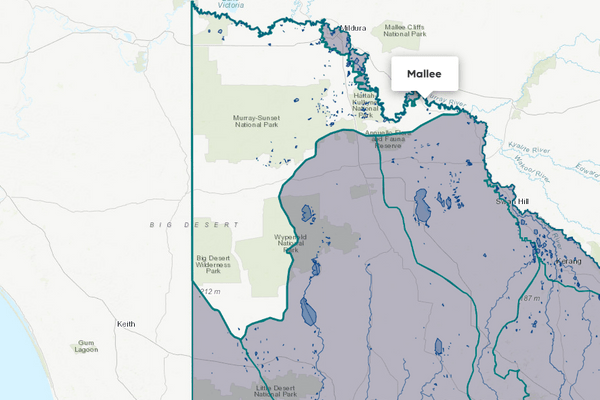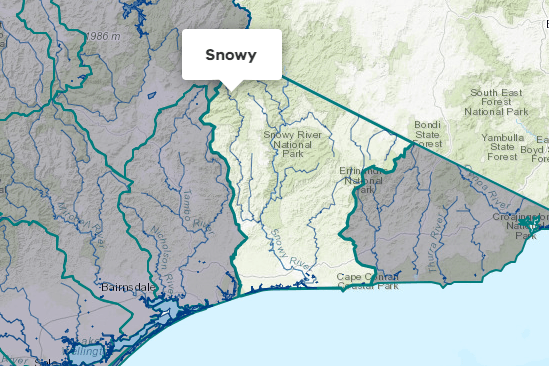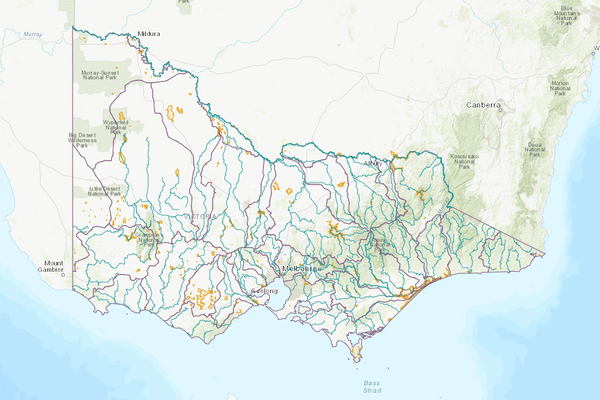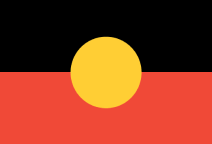About the area
The Murray River forms most of Victoria’s border with New South Wales (NSW). Victoria shares the volume of water held in the major storages with NSW under the Murray-Darling Basin Agreement (MDBA).
For the purposes of these Accounts, the Murray basin refers to five non-contiguous regions, including the Upper Murray basin and four smaller areas in Victoria supplied from the Murray River downstream of Lake Hume. The Murray basin also includes flows in the Lower Broken Creek.
There are typically large volumes of water diverted from the Murray River for irrigation and environmental use. Irrigation diversions support significant agricultural production.
More information on water management and accounting is detailed in Water
2022-23 overview
Available water
Catchment inflow was higher than the previous year.
Licensed diversion restrictions
One creek in the area experienced restrictions compared to zero in the previous year.
Seasonal determinations
The Murray system reached 100% allocation to both high and low-reliability water shares, the same as the previous year.
Water use
Less water was diverted for consumptive purposes than the previous year.
When compared to the previous year, in 2022-23:
- more rainfall was received, and catchment inflow was much higher, the highest volume received in 18 years
- storage levels were slightly lower at the end of the year
- there were more unregulated stream restrictions with a singular ban on licensed diversions
- high-reliability entitlements reached 100% allocation earlier
- low-reliability entitlements received an allocation for the second time since 2016-17
- less water was diverted for consumptive uses
- slightly less water was diverted from the basin for environmental uses.
Climate
2022 Flooding
Through Spring 2022, a series of low-pressure systems or surface troughs travelled over south-east Australia, bringing heavy rainfall and storms. The cumulative impact of these on catchments and waterways led to widespread flooding in several basins. High flows from the Mitta Mitta, Kiewa, Ovens and King, Broken, Edward, Goulburn, Campaspe and Loddon rivers joined the Murray River flows, and contributed to a slow progression of flood peaks along the Murray River.
Rainfall
In 2022-23, rainfall across the Murray basin was very much above the long-term average in most areas, and higher than the previous year. Rainfall was:
- the highest recorded in the reference period (1975 to 2023) in some parts of the upper Murray catchment
- very much above average in the western, central and most of the north-east region of the basin, around Mildura, Swan Hill, Cobram and Lake Dartmouth
- above average in the south of the north-east region around Omeo.
Figure 1 displays the rainfall received in 2022-23 compared to the long-term average (1975-2023).
Figure 1: Rainfall deciles, Murray basin
Sourced from the Australian Bureau of Meteorology
River basin water balance
This section describes the known and estimated inflows, outflows and change of storage volumes in the basin.
In 2022-23, of the total inflows, 64% was passed to other systems, i.e. ceded or spilled to NSW in storages, or flowed to South Australia.
Water balance table
The table below shows the total volumes of water available and supplied from water resources in the Murray basin in 2022-23. This water balance for the River Murray system includes only the Victorian portion of the Murray resource.
The volumes presented in the water balance may not be consistent with the MDBA’s cap compliance reporting due to different accounting methods.
Table 1: Water balance, Murray basin
Major on-stream storages
Major - greater than 1,000 ML - on-stream storages in the Murray basin are included in the water balance. Volumes in off-stream storages are presented for additional information about the resource condition.
Storage levels
Storage levels in the Murray basin were 93% on 30 June 2023.
Lower than the previous year
On 30 June 2022 storage levels were 97% full.
Table 2: Storage levels, Murray basin
Inflows
Catchment inflow
Catchment inflow is calculated based on estimates of inflow to major on-stream storages plus inflow from tributaries.
Catchment inflow in the Murray basin is defined as:
- Victoria’s share of inflow to Lake Dartmouth, Lake Hume, Lake Victoria and the Menindee Lakes system
- Victoria’s share of inflow to the Murray from the Kiewa River
- flow from the Ovens, Goulburn, Campaspe and Loddon rivers and from Broken Creek into the Murray River.
Significantly above average inflows of 17,461,707 ML were received (263% of the long-term average of 6,649,300 ML), approximately double that of the previous year (132% of the long-term average).
Above average inflow received
Catchment inflow was 263% of the long-term average annual volume of 6,649,300 ML.
More water received than the previous year
Catchment inflow was higher than the previous year (132%) and the highest amount received in the 18 years of the Victorian Water Accounts.
Wastewater treatment plants
Water treated at wastewater treatment plants can be used to supplement water available in the basin. Water discharged to waterways from treatment plants is included as an inflow to the water balance.
Information on treatment plants is reported in the water supply local reports for the water corporation responsible for managing the plant.
In this basin, wastewater treatment plants are managed by Coliban East Gippsland Goulburn Valley Lower Murray and North East
Outflows
Diversions
In 2022-23, 1,159,456 ML of water was diverted for consumptive uses - town, domestic and stock, irrigation and commercial supply - and for diversions to wetlands for environmental purposes. This was less than the 1,393,596 ML diverted during the previous year.
Small catchment dams
Water harvested, used and lost by small catchment dams (farm dams) is included in the water balance.
Table 3: Small catchment dams, Murray basin
Entitlements and compliance
Entitlements provide the basis for how water is shared in the basin.
Most entitlements to water in the regulated Murray provide the right to carry over unused allocation to the next season. In the Murray basin, these entitlement holders can carry over unused water up to 100% of their entitlement volume. Water held above entitlement volume is subject to a risk of spill from major storages with 716,298 ML written off due to spill events in 2022-23.
Consumptive diversions under bulk entitlements are assessed against the Murray-Darling Basin annual cap target for the Murray-Kiewa-Ovens Valley. Details of this assessment are published annually in the MDBA’s cap register and annual water take report.
Since 2019-20, the consumptive diversions are also assessed against the annual permitted takes under the Murray-Darling Basin Plan Sustainable Diversion Limit (SDL) compliance reporting which are annually published in the MDBA’s SDL accounts register of take and the Inspector-General of Water Compliance’s SDL compliance statement.
Entitlement volumes
Rights to water in the Murray basin are shown in Table 4.
Entitlement volumes represent a maximum volume of water that can be taken in a one-year period. The volume available in a particular year is dependent on the rules for allocating water set out in the entitlement and the seasonal conditions in that year, which can vary. The rules for allocating water under an entitlement differ between entitlements and systems. This affects the ability and likelihood of water being taken in a particular year.
Table 4: Annual entitlement volumes at 30 June, Murray basin
Available water and take under entitlements
Total water available under entitlements represents the volume of water that was available to be taken by entitlement holders in 2022-23. The volume includes carryover from the previous year, seasonal allocations and net trade into the basin.
Water available under entitlements
High and low-reliability entitlements reached 100% earlier than the previous year.
Water taken under entitlements
There was 1,212,577 ML taken under entitlements in 2022-23, less than the previous year (1,484,984 ML).
Seasonal allocations
- High-reliability entitlement allocations opened at 94% and reached 100% in August 2022 (2 months earlier than the previous year).
- Low-reliability entitlements reached 100% in November 2022 (3 months earlier than the previous year). This was only the second 100% low-reliability allocation in the Murray system since the creation of the current entitlement products in 2007.
Restrictions on licensed diversions from unregulated rivers
- Diversions from Black Dog Creek were banned from March to June 2023.
- All other streams were unrestricted for the year.
- There were no restrictions in place during the previous year.
Available water and take table
This table shows the volume of available water and the volume taken under entitlements in 2022-23.
More information on available water and take has been detailed in How do we account for surface
In 2022-23, a similar volume of water was available under entitlements, but less was taken, compared to the previous year.
Table 5: Available water and take under entitlements, Murray basin
Compliance
Compliance against water entitlements is reported for this basin in 3 areas:
- entitlement issued: that the volume of entitlements issued in a basin does not exceed formal caps, and has not increased without appropriate approvals
- water taken: that the volume of water taken during the year does not exceed the volume considered to be available for consumptive and/or in-stream use during that year
- bulk entitlement provisions: that holders of entitlements do not breach any provisions that are documented in their bulk entitlement orders.
Total entitlement volume
There was an allowed increase in the total entitlement volume from the previous year (an overall increase of 22,088 ML). See note below.
Total volume diverted
The total volume diverted under entitlements (1,212,577 ML) was within the volume available for the year (2,371,257 ML).
Individual bulk entitlements
No individual bulk entitlement holder took more than the annual volume made available to them.
Exceptions to compliance
Individual bulk entitlement holders complied with all provisions in their entitlements. However, some compliance difficulties were experienced. See note below.
Note to increase in total entitlement volume:
- Water share volume increased by 4,266 ML (high-reliability) and 1,601 ML (low-reliability); all of this was issued for the Goulburn-Murray Water Connections Project and Goulburn-Murray Water Water Efficiency Project.
- Bulk entitlement volumes similarly changed due to these projects, with:
- new entitlements to the 3 Melbourne retailers (total increase of 37,960 ML high-reliability and 20,630 ML low-reliability)
- some adjustments to environmental entitlements (increase of 305 ML high-reliability and decrease of 2,663 ML low-reliability)
- a corresponding decrease to loss entitlements.
These changes were commensurate with the irrigation modernisation works completed in line with the Water Act and Water Savings Protocol.
Note to compliance difficulties:
- Goulburn-Murray Water faced compliance difficulties due to extensive flooding from October to December 2022, affecting data quality for bulk entitlements. This impacted accurate tracking of tributary inflows in the Torrumbarry area, River Murray returns, and irrigation area losses.
- Lower Murray Water reported that the water taken at the Lake Cullulleraine off-take exceeded the daily rate listed of 120 ML per day in the bulk entitlement due to increased diversions licensed from the lake, however the volume taken did not exceed the total volume permitted in the bulk entitlement.
Water for the environment
Environmental watering sites
Environmental watering sites in the Murray basin that depend on water for the environment include:
- the Barmah-Millewa Forest, Gunbower Forest, Hattah Lakes and Kerang and Lower Murray Wetlands, which are located along the Murray River and are internationally significant wetlands listed under the Ramsar Convention; except for the Kerang and Lower Murray Wetlands, these are also The Living Murray icon sites
- the Lindsay, Wallpolla and Mulcra islands (also The Living Murray icon sites), which rely on the freshwater inputs from the Murray River to function ecologically.
Environmental water reserve
In 2022-23, water for the environment in the Murray basin comprised:
- the Bulk Entitlement (River Murray - Flora and Fauna) Conversion Order 1999 - Flora and Fauna component, which includes 45,571 ML of high-reliability, 5,860 ML of low-reliability and 49,000 ML of unregulated entitlements held by the VEWH
- the Bulk Entitlement (River Murray - Flora and Fauna) Conversion Order 1999 - Living Murray, which includes 9,589 ML of high-reliability, 101,850 ML of low-reliability and 34,300 ML of unregulated entitlements held by the VEWH on behalf of the MDBA
- the Bulk Entitlement (River Murray - Flora and Fauna) Conversion Order 1999 - Barmah-Millewa Forest Environmental Water Allocation, a significant operational rule embedded in consumptive entitlements comprising 50,000 ML of high-reliability and 25,000 ML of lower security entitlements
- the Bulk Entitlement (River Murray - Flora and Fauna) Conversion Order 1999 - River Murray Increased Flows, comprising Victoria’s share of water recovered under the Snowy Water Initiative released from the Snowy Scheme to the River Murray, held by the VEWH
- the Environmental Entitlement (River Murray - NVIRP Stage 1) 2012, which includes allocated mitigation water for the purposes of watering specific environmental sites that have been identified through Goulburn-Murray Water Connections Project environmental approvals processes (1,207 ML of allocation in 2022-23)
- the Bulk Entitlement (River Murray - Snowy Environmental Reserve) Conversion Order 2004, comprising 29,794 ML of high-reliability entitlements, held by the VEWH
- 393,294 ML of high-reliability water shares and 43,025 ML of low-reliability water shares held for the environment
- water set aside for minimum flows released by the MDBA as a condition of the Murray-Darling Basin Agreement
- water set aside for the environment through flow-sharing arrangements set out in North East Water’s and East Gippsland Water’s bulk entitlements from unregulated rivers
- all other water in the basin not allocated for consumptive uses: this water also provides social, recreational and cultural benefits.
Environmental water use
A total of 273,764 ML of environmental water was sourced from the Murray basin in 2022-23. Of this, 95,441 ML was diverted off-stream. The remaining 178,324 ML was delivered in-stream in the Murray River.
A total of 482,221 ML of Victorian environmental water crossed the South Australian border. This delivery was supplied from environmental water entitlements in the Murray, Goulburn, Campaspe and Loddon systems.
Management responsibilities
Management of water in the Murray basin is undertaken by various parties.
The MDBA operates the Murray River on behalf of the Victorian, New South Wales and South Australian governments in accordance with the water-sharing arrangements set out in the Murray–Darling Basin Agreement. Under the agreement, Victoria shares the waters of the Murray River with New South Wales and South Australia.
Under normal conditions, Victoria is entitled to a 50% share of all flows upstream of Doctors Point near Albury–Wodonga (that is, flows to Hume and Dartmouth reservoirs and from the Kiewa River), a 50% share of inflows to the Menindee Lakes storage and all flows entering the Murray from the Ovens, Goulburn, Broken, Campaspe and Loddon rivers. Victoria is also required to supply half of South Australia's monthly entitlement flows from the water available to it.
| Authority | Management responsibilities |
|---|---|
| Murray-Darling Basin Authority |
|
| Mallee Catchment Management Authority |
|
| Goulburn Broken Catchment Management Authority |
|
| North Central Catchment Management Authority |
|
| Water New South Wales |
|
| South Australian Water Corporation |
|
| Goulburn-Murray Water |
|
| Lower Murray Water |
|
| North East Water |
|
| Goulburn Valley Water |
|
| Coliban Water |
|
| East Gippsland Water |
|
| Department of Energy, Environment and Climate Action (Victoria) |
|
| Grampians Wimmera Mallee Water |
|
| North East Catchment Management Authority |
|
| Water supply system | 2021-22 (ML) | 2022-23 (ML) |
|---|---|---|
| Barmah | 46 | 39 |
| Bellbridge | 58 | 64 |
| Cobram system | 2,570 | 2,684 |
| Cohuna system | 552 | 667 |
| Corryong system | 253 | 275 |
| Dartmouth | 20 | 24 |
| Echuca | 3,504 | 2,989 |
| Eskdale | 12 | 12 |
| Gunbower | 56 | 68 |
| Katamatite | 58 | 58 |
| Kerang | 1,084 | 970 |
| Koondrook | 250 | 215 |
| Leitchville | 258 | 288 |
| Mildura system | 13,400 | 12,286 |
| Murrabit | 36 | 30 |
| Mystic Park | 11 | 9 |
| Nathalia | 562 | 508 |
| Numurkah system | 883 | 872 |
| Omeo | 44 | 45 |
| Piangil | 149 | 133 |
| Picola | 11 | 11 |
| Red Cliffs | 1,363 | 1,218 |
| Robinvale | 576 | 544 |
| Rutherglen/Wahgunyah system | 619 | 691 |
| Swan Hill system | 3,873 | 3,544 |
| Tallangatta | 147 | 156 |
| Walwa | 15 | 16 |
| Wodonga system | 6,257 | 6,881 |
| Yarrawonga system | 1,305 | 1,417 |
| Water supply system | 2021-22 (ML) | 2022-23 (ML) |
|---|---|---|
| First Mildura Irrigation District | 34,156 | 27,136 |
| Merbein Irrigation District | 17,986 | 14,624 |
| Murray Valley Irrigation Area | 190,388 | 184,185 |
| Nyah Irrigation Area | 5,158 | 4,075 |
| Red Cliffs Irrigation District | 32,234 | 25,881 |
| Robinvale Irrigation District | 18,124 | 14,850 |
| Torrumbarry Irrigation Area | 490,359 | 442,413 |






